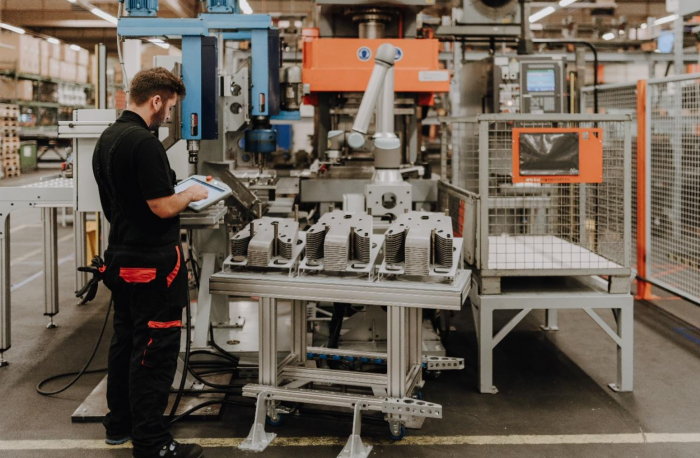König+Neurath: Office furniture manufacturer relies on industrial robots

The key data with which Timo Huss describes the production facility of the Hessian furniture manufacturer sound impressive: 120,000 square meters of space spread across four halls. 10,000 parts in the metal processing alone. Among them, 400-500 cable trays for desks leave the factory every day. Keeping track of all this is quite an achievement.
The production manager, together with the mechanical engineering technician Roland Fritscher, guides us through the metal production hall at König + Neurath. Office furniture has been manufactured here in Karben, Hesse, for almost a hundred years. During this time, the work at the company’s location has undergone significant changes – and so has the workplace. “We are always making some changes,” says Huss as a small, ankle-high cart with blinking lights passes by. It’s one of the new automated transport systems implemented a year ago for the internal transport of pallets and grid boxes. “We must adapt our working methods to the changing requirements of our customers. Our goal is to produce more efficiently and quickly, minimize errors, and make the best possible use of our capacities.”
Since 2018, the approximately 600 employees in the production halls of the family-owned company have been receiving increased support from industrial robots and collaborative robots, known as Cobots. In fact, König + Neurath has an above-average density of robots compared to the German industry: Currently, the office furniture manufacturer has 18 installed and plans to deploy additional industrial robots. Roland Fritscher is also responsible for this. Together with the employees, he analyzes the work processes in the production facilities and regularly develops new ideas on how to make them even more efficient. Sometimes, he finds the approach for technological optimization at trade fairs or even on YouTube.
The nature of work is changing: programming instead of operating machines. The question that arises in the face of this development is whether employees are becoming redundant. “On the contrary,” says Timo Huss. “The tasks of our employees are changing. Instead of operating machines, they are more likely to take on picking or programming the industrial robots themselves.” According to the mechanical engineering technician Fritscher, this makes jobs in production even more attractive. “Four out of ten people in our plant construction can program. That is the goal of all mechatronics. In our field, there are hardly any companies that offer young people such opportunities like we do.”
König + Neurath also relies on automation in plant and fixture construction to remain future-proof. The experts are confident that they can implement everything technologically: Employees plan the systems, weld them, and program the robots. Even apprentices develop their own robot with a camera for testing and practice. Once it’s completed, they receive a new one. “For us, automation is not only a solution for more process security and flexibility but also an answer to the shortage of skilled workers,” says Timo Huss. Dirk Fischer, COO of König + Neurath AG, adds, “In 2021, we adopted an automation strategy for the implementation of automated guided vehicles, Cobots, and industrial robots. I am proud of our employees for the speed with which these projects are implemented and driven forward with continuous improvement processes (KVP).”
Unique Selling Proposition: Products from In-House Manufacturing
Having consolidated expertise in-house provides König + Neurath with greater freedom in the production of office furniture and room systems. Regardless of how complex the product is, it is almost entirely manufactured on-site. This can be done either in a traditional hands-on manner, such as in the sewing workshop, or with the support of Cobots and automated guided vehicles. This approach puts the entire process under control, ensures absolute transparency – particularly advantageous in terms of sustainability – and grants the highest level of independence. Therefore, investing in Cobots and industrial robots is indeed worthwhile.
The numbers speak for themselves: Once an industrial robot is assembled for testing, it takes only about two to three weeks to make it operational. The return on investment typically ranges between one and three years. According to the production manager, in most cases, the investment has already paid off within a year.
For more information, please visit: https://www.koenig-neurath.com/en/
News Categories
- » NEWS HOME
- » Automation & Robotics
- » Industry 4.0
- » Material Handling
- » Sensors
- » Quality & Testing
- » Machine Vision
- » Laser & Optics
- » Metalworking
- » Motion Control & Drives
- » Hydraulics & Pneumatics
- » Process Industry
- » Renewable Energy
- » Agriculture
- » Home & Office Furniture
- » Environmental Tech

